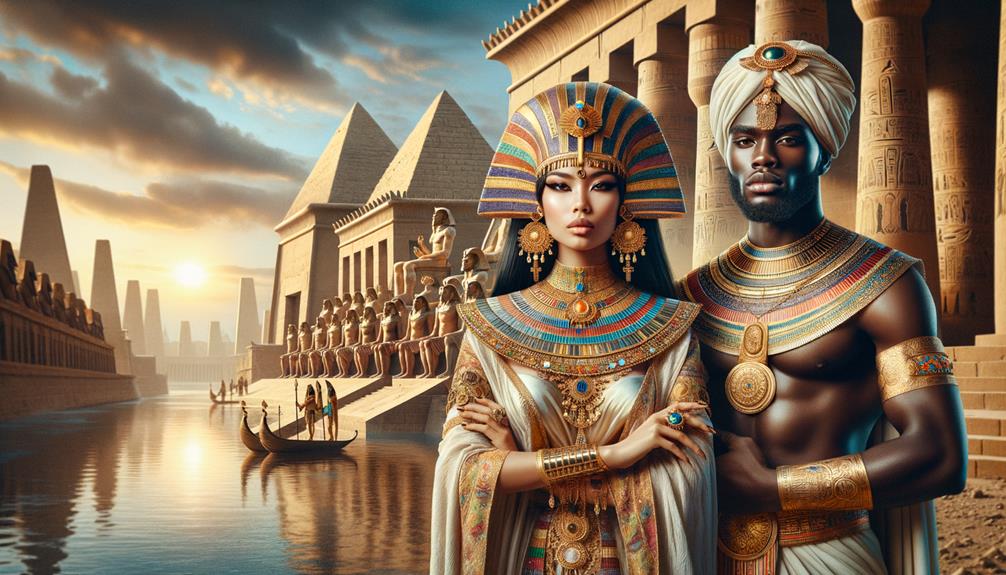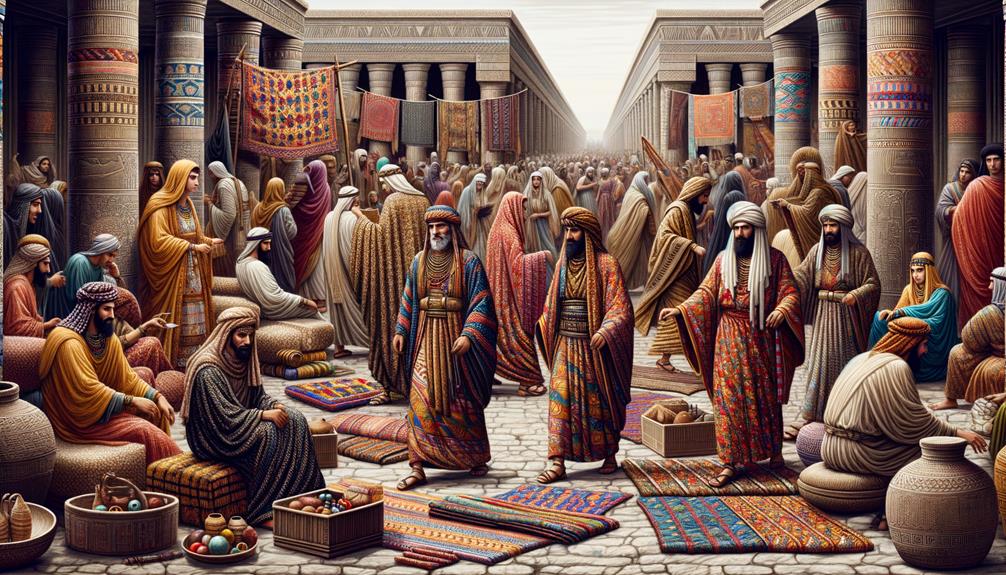The vibrancy of Minoan fashion is a striking contrast to the often subdued tones of other ancient cultures. I'm captivated by the intricate designs and vivid colors in their frescoes. These images not only show clothing, but also reveal a complex social hierarchy. Jewelry and accessories play a significant role, indicating wealth and status. The garments differ greatly between classes, with nobles wearing luxurious fabrics. It's fascinating how these visuals serve as both personal expression and social commentary. What deeper meanings might we uncover in these ancient depictions of attire and adornment?
Minoan Women's Fashion
Minoan women's fashion reflected their society's values and aesthetics in a unique way. Observing the frescoes, it's clear that the Minoan culture cherished intricate designs and vibrant colors. Women wore long, slit dresses, some of which exposed their breasts, indicating a society that was unapologetic about the human form. The wide belts and embroidered aprons they wore suggest a blend of functionality and decoration, emphasizing both practicality and visual appeal.
The distinct nature of Minoan clothing reveals a culture that placed importance on distinct roles and identities. Women's fashion was particularly more elaborate than men's, highlighting a ritualistic significance. The hats they wore and the detailed embroidery on their aprons indicate a sophisticated approach to everyday attire.
As time passed, frescoes depict an evolution in dress styles, reflecting changes in societal values and aesthetics. These images show that Minoan women didn't just follow fashion – they created it. Their clothing choices were deliberate, showcasing the society's appreciation for beauty and innovation. The vibrant colors and intricate patterns speak volumes about a culture that celebrated creativity and individuality. Through their fashion, Minoan women conveyed a rich tapestry of cultural identity and personal expression.
Minoan Men's Attire
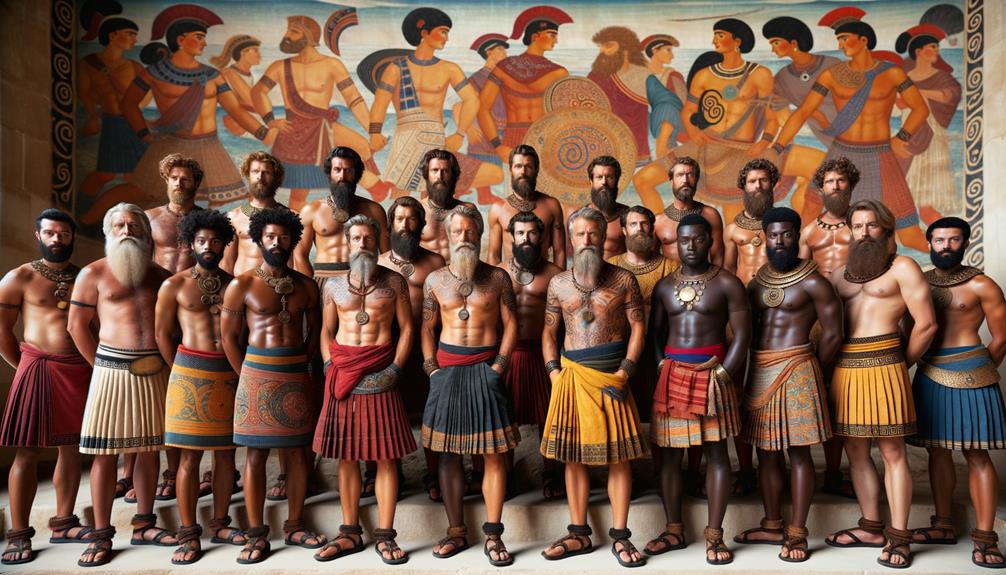
Minoan men's attire was characterized by minimal clothing that showcased their active lifestyle and military prowess. They primarily wore loincloths and kilts, which revealed their well-muscled bodies, demonstrating their dynamic existence. Minoan fashion for men was both functional and aesthetically pleasing, as depicted in various frescoes and figurines.
| Clothing Item | Purpose | Materials |
|---|---|---|
| Loincloths | Daily wear | Linen, Wool |
| Kilts | Formal occasions | Linen, Wool |
| Men's shorts | Athletic activities | Leather, Linen |
| Pointed hats | Status symbol | Feathers, Fabric |
| Tunics | Everyday comfort | Linen |
Minoan men's attire evolved over time, influenced by neighboring cultures like Egypt. Their clothing often featured vibrant pointed hats, adding a touch of elegance and status. Frescoes and figurines from this era offer us a glimpse into their world, showcasing a blend of practicality and beauty.
It's clear that the innovation in Minoan fashion wasn't just about appearance. It was about crafting attire that suited their active lives. Each piece served a purpose, whether for daily tasks, athletic events, or ceremonial occasions, revealing a culture that valued both function and form.
Minoan men's fashion was more than just about looking good; it was about creating clothing that worked for their lifestyle. They prioritized comfort and practicality without sacrificing style, resulting in a unique blend of form and function.
Jewelry and Accessories
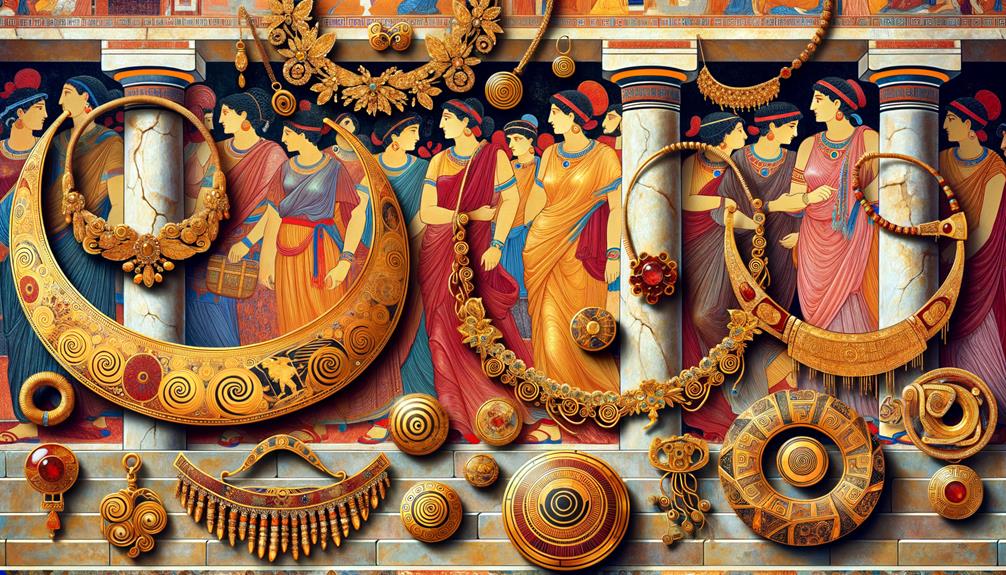
When I think of Minoan jewelry, I immediately picture intricate gold pieces adorned with symbolic motifs. The shell and stone beads, crafted with great care, hold significant importance. The hair ornaments, rich in meaning, highlight the deep connection between adornment and cultural identity.
Exquisite Gold Adornments
Minoan gold jewelry, with its intricate beadwork and symbolic motifs, reflected both wealth and artistry in ancient society. These pieces weren't just accessories; they were statements of status, carefully crafted to convey power and sophistication. The use of gemstones like lapis lazuli added color and significance, transforming each piece into a miniature work of art.
Reflecting on the craftsmanship, I'm struck by the meticulous attention to detail. Each bracelet, each hoop earring, was a testament to their advanced metallurgical skills. The symbolic motifs—often bulls or snakes—carried deep cultural meanings, perhaps used in rituals to invoke protection or prosperity.
The importance of adornment in Minoan culture cannot be overstated. Gold jewelry wasn't merely decorative; it played a significant role in ceremonies and daily life. The artistry involved speaks volumes about their societal values and the emphasis placed on visual expression.
- Gold Jewelry: A status symbol in ancient society.
- Gemstones: Lapis lazuli added color and significance.
- Motifs: Bulls and snakes symbolized cultural beliefs.
- Craftsmanship: A testament to advanced metallurgical skills.
These adornments, intricate and meaningful, offer a window into the sophistication of Minoan society.
Shell and Stone Beads
Beyond the allure of gold, the Minoans cherished the natural beauty of shell and stone beads in their jewelry and accessories. These materials weren't just decorations; they told stories of the sea and earth. Shell beads, crafted from local marine treasures, reflected the Minoans' deep connection to the ocean. On the other hand, stone beads like agate and carnelian brought a burst of color and intricate patterns to their pieces.
In Knossos, the heart of Minoan civilization, archaeologists have unearthed numerous examples of these beads, showcasing their significance. The craftsmanship was meticulous, often integrating shells and stones with gold for stunning results.
| Material | Source |
|---|---|
| Shell Beads | Local marine resources |
| Stone Beads | Agate, carnelian |
| Combination | Gold, shells, stones |
| Location | Knossos archaeological site |
Each bead held meaning, a reflection of the Minoans' innovative spirit. They saw beauty in the natural world and transformed it into wearable art. These beads weren't mere decorations; they were expressions of identity and reverence for nature. In every shell and stone, one can glimpse the essence of Minoan culture—a blend of artistry and connection to the world around them.
Symbolic Hair Ornaments
Intricately crafted hair ornaments adorned the heads of Minoan women, reflecting their social standing and personal aesthetics. These symbolic hair ornaments weren't just accessories; they conveyed a message. From the gleam of gold jewelry to the shimmer of beads, each piece told a story.
In Minoan culture, hair ornaments held significant meaning. They symbolized:
- Social status: The more exquisite the ornament, the higher the woman's rank.
- Fertility: Motifs like bulls and snakes carried powerful meanings.
- Wealth: Crafted from gold and gemstones, they showcased the wearer's affluence.
- Personal style: Each design echoed individual taste and creativity.
The artistry behind these hair ornaments is striking. Gold jewelry and beads were meticulously fashioned, often incorporating intricate motifs that spoke volumes about the wearer's identity. Bulls and snakes, common symbols, represented fertility and power, intertwining personal aesthetics with deeper cultural narratives.
Reflecting on these accessories, it's clear that Minoan women used them to enhance their everyday hairstyles. They weren't just adding beauty; they were embedding layers of meaning and tradition into their hair, creating a rich tapestry of symbolism and luxury that defined their place in society.
Hairstyles and Cosmetics
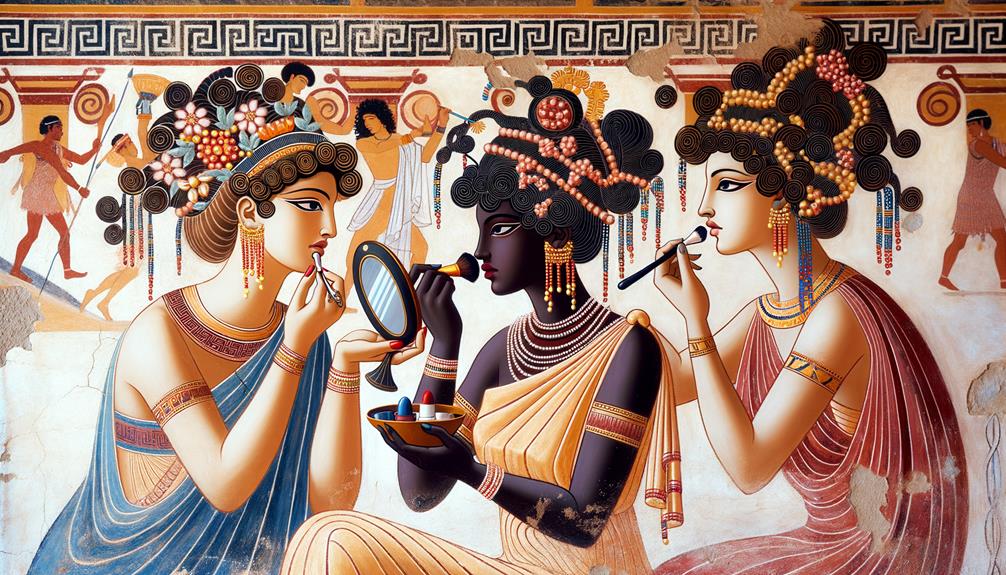
In ancient Crete, hairstyles and grooming practices played a significant role in defining one's status and beauty. In Minoan society, hairstyles weren't just about aesthetics; they held deep symbolic meaning. Women often styled their hair in intricate braids, curls, and updos, adorned with ribbons and beads. These styles were more than just fashion statements – they reflected one's social standing and personal grooming practices.
Men, on the other hand, opted for clean-shaven faces, emphasizing a polished, well-maintained appearance. Both genders engaged in beauty rituals that included the use of cosmetics and natural oils. These rituals weren't just about vanity; they were deeply embedded in their culture and daily life. Cosmetics enhanced their features, while oils nourished the skin, highlighting their commitment to self-care.
Grooming practices in Minoan society were meticulous and deliberate. The act of grooming transcended mere routine; it was a reflection of societal norms and ideals of beauty. Every braid and curl, every clean shave, spoke volumes about one's place in society and their adherence to cultural values. In many ways, these practices were both personal expressions and public declarations of identity and status.
Fashion in Frescoes
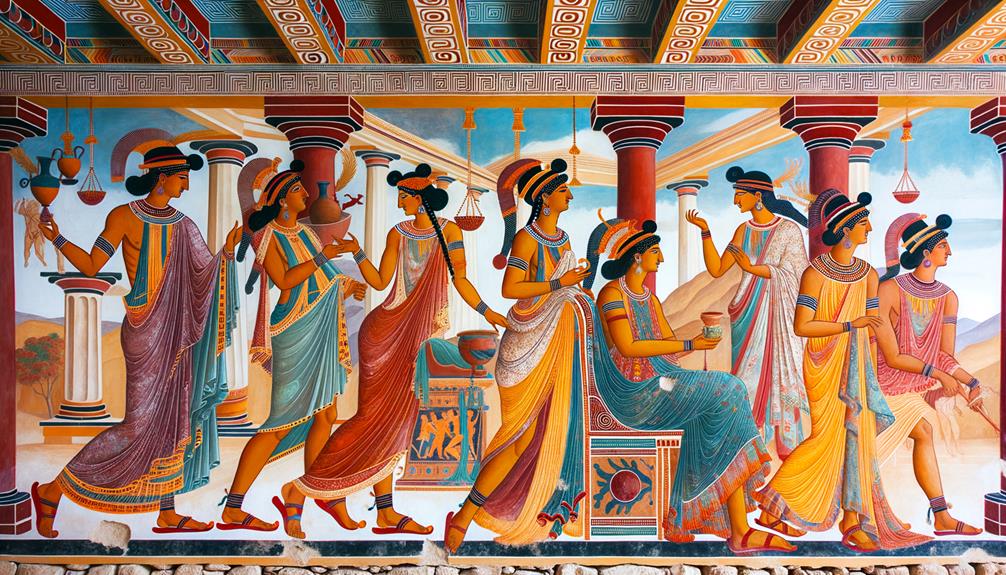
Minoan frescoes offer a vibrant glimpse into the fashion of the time, revealing a great deal about their society. The intricate clothing styles depicted in these artworks reflect the complexities of the Minoan civilization. From ornate dresses to simple tunics, these frescoes showcase a range of attire that highlights the social divisions within their society.
Observing these frescoes, I notice the following elements:
- Clothing styles vary greatly, from elaborate gowns for the elite to functional garments for commoners.
- Jewelry is frequently worn, indicating its significance across different social classes.
- The attire clearly distinguishes between nobles, commoners, and rustics.
- Wool is the primary material used, depicted in intricate patterns and textures.
The evolution of these styles is striking. Over time, regional trends emerge, illustrating a dynamic interplay between fashion and social identity. The widespread use of jewelry in these frescoes further emphasizes its cultural significance. The meticulous depiction of wool in the artwork underscores its central role in Minoan clothing.
In these frescoes, the Minoans have left a vivid record of themselves, their societal structures, and their values. The clarity with which their fashion is portrayed provides a unique lens into the past, reflecting a civilization where attire was more than just clothing – it was a statement.
Social Status and Clothing
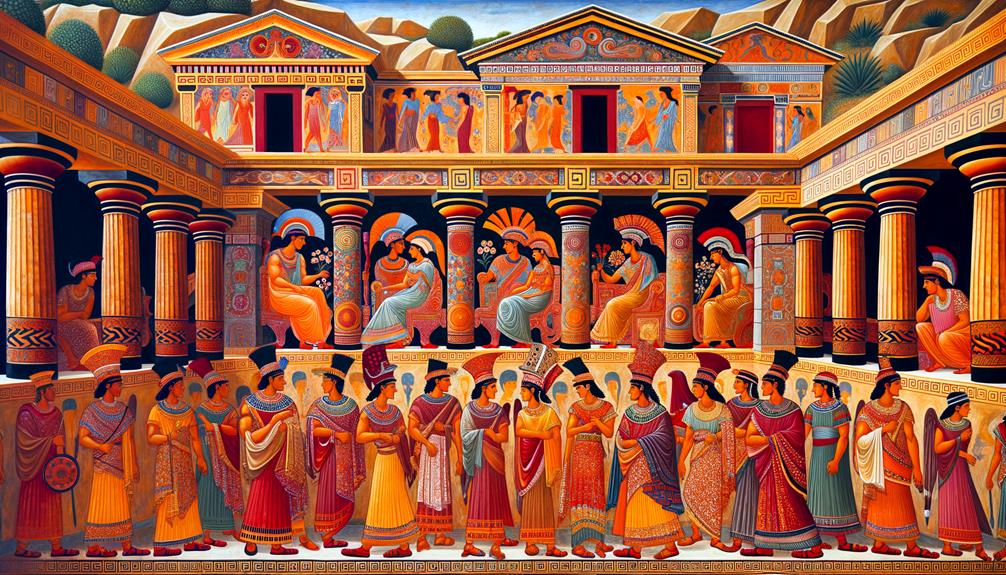
In Minoan society, clothing was more than just a fashion statement – it was a clear indicator of one's social standing. The elaborate garments worn by nobles, adorned with intricate designs and luxurious fabrics, set them apart from the simpler clothing styles of commoners. Every piece of attire and accessory was chosen deliberately to reflect an individual's position within the social hierarchy.
Jewelry also played a significant role in distinguishing social status. Nobles wore opulent pieces crafted with fine materials, while commoners wore simpler, less ornate items. This visible distinction was echoed in the frescoes that depicted vivid scenes of everyday life.
I find it fascinating how each element of clothing and accessories was a deliberate choice, a symbol of identity and position.
The social hierarchy was clearly defined through clothing and accessories:
- Nobles: Luxurious fabrics, intricate designs, and opulent jewelry
- Commoners: Simpler fabrics, modest designs, and basic jewelry
- Rustics: Coarse fabrics, minimalistic designs, and little jewelry
- Men: Waistcloths, tunics, and occasional jewelry
- Women: Flounced skirts, bodices, and elaborate necklaces
Through their clothing and accessories, Minoans communicated their social standing without needing to say a word. The layers of fabric and the gleam of jewelry told stories of power, wealth, and identity in a world long past.
Influence on Later Cultures
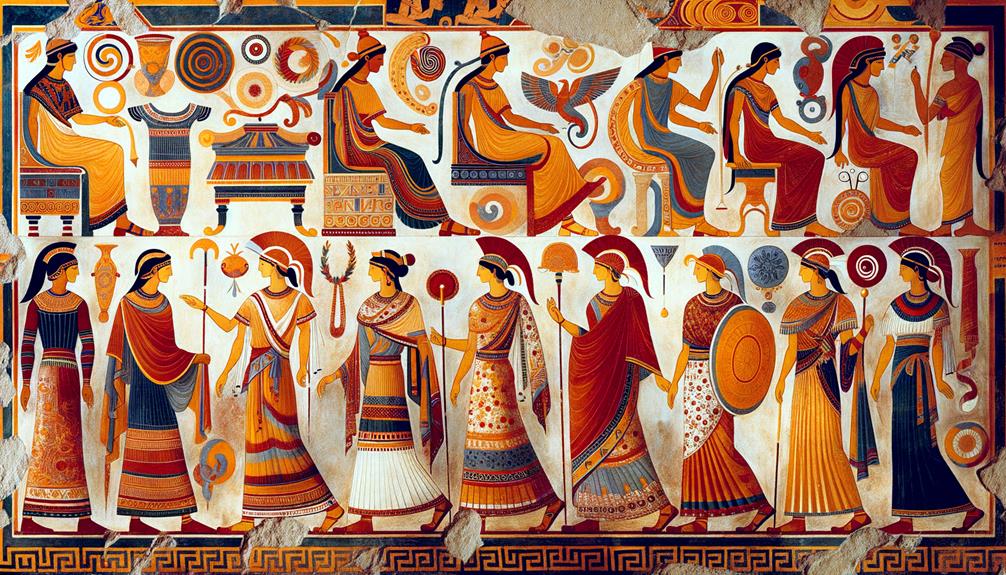
The Minoans' distinct fashion style didn't stop at Crete's borders; it had a lasting impact on the sartorial choices of later Greek and Roman cultures. Minoan frescoes, with their meticulous depictions of attire, set a standard for artistic representations in these subsequent societies. The luxurious garments and intricate designs seen in Minoan fashion found echoes in the Mediterranean cultures that followed.
Several key influences stand out:
- Vibrant textiles: The Minoans' bold use of color in their fabrics inspired similar choices in later Greek and Roman clothing styles.
- Intricate patterns: The complexity of Minoan designs resonated in the detailed embroidery and decorations of later eras.
- Practical yet stylish garments: The blend of practicality and beauty in Minoan attire set a benchmark for fashion trends across the ancient world.
- Cultural significance: Minoan frescoes highlighted the cultural heritage of their fashion, embedding symbolic meaning that persisted in future artistic expressions.
The heritage of Minoan fashion and frescoes is a testament to the enduring impact of their cultural legacy. These elements didn't simply fade away; they transformed and enriched the sartorial and artistic landscapes of later Mediterranean cultures.
Frequently Asked Questions
What Was the Fashion of the Minoans?
Minoan fashion is characterized by vibrant and intricate designs, showcasing their advanced aesthetic sense. Men typically wore minimal clothing, including loincloths and cloaks, while women adorned themselves with skirts and corsets. Both sexes exuded elegance, significantly influencing later Mediterranean styles.
What Did Minoan Frescoes Depict?
I once stumbled upon a Minoan fresco that felt like a snapshot of daily life, showcasing nobles, commoners, and rural workers going about their daily routines. These vibrant artworks are like ancient snapshots, reflecting the complex social hierarchy and lively interactions of the time.
What Are the Characteristics of Minoan Frescoes?
Minoan frescoes are renowned for their vivid colors, intricate details, and lifelike representations. These artworks showcase the advanced skills of Minoan artists, who masterfully crafted dynamic scenes that reflect everyday life in ancient Crete. From capturing elaborate religious ceremonies to depicting serene nature scenes and social hierarchies, Minoan frescoes display remarkable precision and creativity.
What Was the Minoan Art Style Like?
Imagine a vibrant tapestry of life, where dynamic shapes and colors dance across the canvas, capturing the essence of nature and daily life. Minoan art is a celebration of fluid lines, vivid hues, and the beauty of everyday moments, frozen in time.



